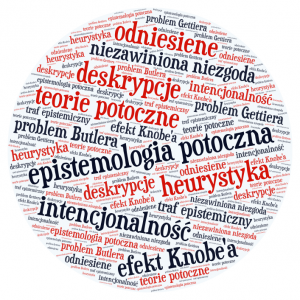Seminarium poświęcone zagadnieniom związanym z potocznymi teoriami przyczynowości badanymi w ramach filozofii eksperymentalnej.
Prowadzący: Katarzyna Kuś, Adrian Ziółkowski
BLOK I: Normalność i typowość
- Knobe, J., Fraser B. (2008). Causal judgment and moral judgment. Two experiments, in: Walter Sinnott-Armstrong (Ed.): Moral psychology. Vol. 2. The cognitive science of morality. Intuition and diversity. Cambridge: The MIT Press, pp. 441-447.
- Roxborough C., Cumby J. (2009). Folk psychological concepts. Causation, Philosophical Psychology 22 (2), pp. 205-213.
- Sytsma, J., Livengood, J., & Rose, D. (2012). Two types of typicality: Rethinking the role of statistical typicality in ordinary causal attributions. Studies in History and Philosophy of Science Part C, 43(4), 814-820.
BLOK II: Odpowiedzialność i wina
- Hitchcock, C., & Knobe, J. (2009). Cause and norm. The Journal of Philosophy, 106(11), 587-612.
- Alicke, M. D., Rose, D., & Bloom, D. (2011). Causation, norm violation, and culpable control. The Journal of Philosophy, 108(12), 670-696.
- Alicke, M., & Rose, D. (2010). Culpable control or moral concepts?. Behavioral and brain sciences, 33(4), 330-331.
- Danks, D., Rose, D., & Machery, E. (2014). Demoralizing causation. Philosophical Studies, 171, 251-277.
- Rogers R. et al. (2019). Causal deviance and the ascription of intent and blame, Philosophical Psychology 32 (3), pp. 404-427.
BLOK III: Wybór przyczyny (causal selection) i myślenie przyczynowe
- Kominsky J. et al. (2015). Causal superseding. Cognition 137 (C):196-209.
- Icard, T., Kominsky J., Knobe J. (2017). “Normality and actual causal strength”, Cognition 161, pp. 80-93.
- Morris, A. et al. (2019). “Quantitative causal selection patterns in token causation”, PLOS ONE 14 (8)
- Quillien T. (2020). “When do we think that X caused Y?”, Cognition 205, 104410.
- Gill M. et al. (2022). “An interaction effect of norm violations on causal judgment”, Cognition 228, 105183.
BLOK IV: Zaniechania i niedziałania
- Livengood, J., & Machery, E. (2007). The folk probably don’t think what you think they think: Experiments on causation by absence. Midwest Studies in Philosophy, 31(1), 107-127.
- Clarke, R. et al. (2015): Causation, norms, and omissions. A study of causal judgments, Philosophical Psychology 28 (2), pp. 279-293.
- Willemsen P., Reuter K. (2016). Is there really an omission effect?, Philosophical Psychology 29 (8), pp. 1142-1159.
- Henne P. et al. (2019). A counterfactual explanation for the action effect in causal judgment, Cognition 190, pp. 157-164.
BLOK V: Porządek czasowy, udaremnianie i podwójne zapobieganie
- Lombrozo, T. (2010). Causal–explanatory pluralism: How intentions, functions, and mechanisms influence causal ascriptions. Cognitive psychology, 61(4), 303-332.
- Reuter K., et al. (2014). The good, the bad, and the timely. How temporal order and moral judgment influence causal selection, Frontiers in Psychology 5, 1336, 1-10.
- Henne P. et al. (2021). Counterfactual thinking and recency effects in causal judgment. Cognition, 212, 104708, 1-16.
- Henne P., O’Neill K. (2022). Double prevention, causal judgments, and counterfactuals, Cognitive Science 46 (5), e13127, 1-25.

